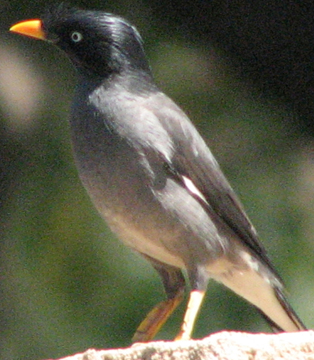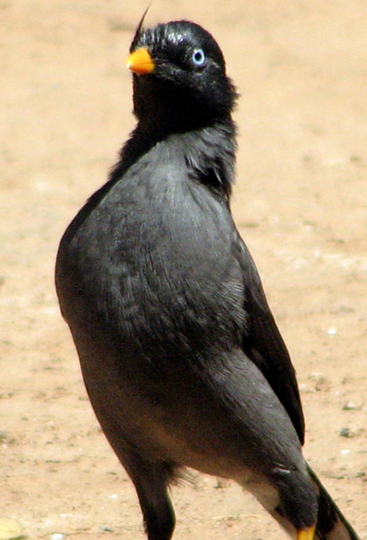Jungle Myna ( Acridotheres fuscus )
-Ragoo Rao
I have chosen the Jungle Myna for the " Common Birds" section this month as the Mynas are busy in this season breeding and their activities could be studied by the interested.
 India has quite a few species of Mynas.
Six to be precise. The most common is the Common Myna and the rare being the Pied Myna.
India has quite a few species of Mynas.
Six to be precise. The most common is the Common Myna and the rare being the Pied Myna.
The Jungle Myna is very similar to the common Myna but there is a color variation.
The first recognition point being absence of the yellow bare parts around the eyes, but with
a crest of short feathers on the head. The body is also more grayish brown but the white patches on the wing side are similar to the common Myna. These Mynas are not usually found with the other common Mynas but keep themselves to tall treed areas. Huge
compounds with very tall and old Raintrees are ideal locations to find these Mynas. Somehow these Mynas do not feel comfortable with human habitation, they seem to like quiet wooded areas.
The distribution is throughout the country, except for very high altitudes.
These birds are often found in pairs and sometimes even in flocks of 15 to 20 birds all foraging on the ground looking for tit-bits and insects. At the slightest intrusion
these birds take off instantly with the characteristic Keeeeeek.....keeeeek alarm calls.
In the country side one could notice these birds tagging behind grazing cattle to get at the insects disturbed by the cattle. They walk along with the cattle with an upright stance and long strided walk all the time keeping vigil for any human intrusion.
One could even see these birds sitting on buffaloes backs or horns looking for parasitic insects on the buffaloes body. 
The Erythrina blooms attract these birds in large flocks and they seem to love the nectar of these flowers.
All varieties of wild figs are also their favourite among fruits. These birds are omnivorous, but the young are brought up only on insects, probably because of the high protein content.
The nesting season is from February to July. The nest is built from dried grass and rubbish and lined with feathers. The nest is a natural small hole in tall rain trees
and other fig trees. In the wooded country side if there are any abandoned buildings with rafters and crevices they easily take up to nesting in these places, which shows these birds share a common character with the Common Myna in nesting habits.
Usually 3 to 4 glossy turquoise blue eggs are laid and both parents share all domestic chores.
This part of the year is ideal to locate these birds in their habitats and study them.